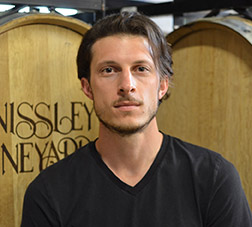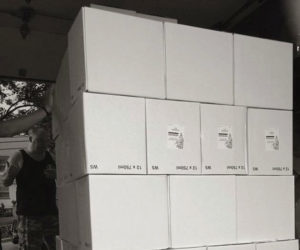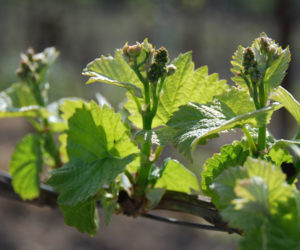Fruit wines often benefit from backsweetening to help make the fruit’s flavor more recognizable after its natural sugars are fermented out. Two fruit winemakers share their sweet tips for successful backsweetening.
Kyle Jones, Head Winemaker at Nissley Vineyards in Bainbridge, Pennsylvania

Pretty much all of our wines start as a blend of finished dry wines. The wines that are to become bottled sweet wines, Grapeful Red for example, are then backsweetened using 100% dry granulated sugar (sucrose), usually made from sugar beets because that is the most cost-effective domestic source of granulated sugar. Using dry sugar we are not diluting our base wine any more than the volume the dissolved sugar takes up. We don’t use fruit juice or concentrated juice to sweeten because it requires a lot more volume of the sweetener to achieve our desired sweetness level. In essence, we are replacing some of the sucrose that the yeast used up in the process of making alcohol.
I like to add all sugar before any final stabilization processes. Any fining to achieve heat stability or colloid stability is carried out as a whole blend, to ensure a successful stabilization. Once the sweetened blend is stable from that perspective, crossflow filtration ensures microbial stabilization and final clarity. Going into the bottling line the wine passes through a final 0.45-micron absolute sterile cartridge filter to catch any stray microbial particulates. I don’t use any chemical sterilizers on our wines other than sulfur dioxide in the form of added potassium metabisulfite, which serves as more than just an antimicrobial.
A panel of 5–10 staff members conduct tasting trials before we do any blending. We are all familiar with our
wines, and each year we trial several blends to ensure we are producing consistent products from vintage-to-vintage. Most of our wines have a defined level of sweetness based on consumer demand. For those wines that do allow for vintage-to-vintage variation we look for the point of balance between sweetness and acidity. On wines that are off-dry we might not want to dampen the acidity too much because it is part of the stylistic presentation. In this case we experiment with sweetening to help fill out the body or mid-palate. In these instances, we are only looking to add several grams/liter, as opposed to some of our very sweet wines that reach up into the realm of 120 g/L added sugar.
The goal has always been to find the balance between the natural acidity and the added sugar. In a fruit wine that means finding that point where drinking the wine makes you feel like you just bit into the fresh piece of fruit without exaggerating that point by adding too much sugar. Sugar and acid don’t replace flavor, they simply help to elevate it. Experimentation and trials are always the default method for finding that balance.
When it comes to the level that you are adding, approach it from the perspective of the wine first. Find that balance (whether it is fruit wine or wine from grapes). Don’t worry about whether or not sweetness makes a wine second rate. If you have the acidity like we do in the east, we do ourselves a disservice by leaving it out of balance. Some of the most sought after, age-worthy wines in the world are sweeter than some people like to admit. Lastly, stability is key, adding sugar to a dry wine that isn’t 100% microbially stable will teach you a lesson every time. If you can’t guarantee its stability, just buy thicker bottles and put a crown cap on the top. You’ll still like the result.
Rex Johnston, award-winning amateur winemaker

I start with 100% fruit juice before fermentation and sweeten all of these wines with table sugar (sucrose) as it is easy to obtain and least costly. Quite often I concentrate the fermented wine further by freezing and collecting the thawed juice in fractions I keep separate and then blend back (the first portion has the highest alcohol and acid and the numbers decrease with each subsequent fraction, while the pH gets higher for each fraction). Also, one can freeze the unfermented juice and do the same process to increase the intensity of the fruit. Both of these are done before the final sugar addition for balance and should be added after conducting bench trials.
Prior to backsweetening I stabilize by adding ½ teaspoon potassium sorbate per gallon (3.8 L), stir to dissolve, and then sterile filter.
The amount of sugar to add is decided by doing bench trials in which I have 3–4 people arrive at a consensus to find the right balance.
As an example of the process I will use my elephant heart plum wine made from the fruit of trees in my backyard. We usually begin with 5–10 gallons (19–38 L) of juice that has completed fermentation and is dry. From past experience, we begin with 10% by weight sugar and make additional solutions up to 20% in 2% increments. The wine fermented to dryness can be considered to have 0% sugar by weight. If you weigh 90 grams of 0% sugar wine and add 10 grams of sugar, you will have 10% by weight of sugar in the fermented wine. Similarly, you prepare 12% by weight, 14% by weight, 16% by weight, 18% by weight and 20% by weight. Then you get about four friends who each have six glasses with about 15 mL of each solution in front of them. Then you all come to agreement as to which tastes best.
The amount of sugar varies by fruit, but I usually arrive at a sugar level of 2% to 18% to achieve balance. Raspberries and other berry seed fruit are very acidic (and thus require more sugar to balance). Plums are less acidic, and then peaches and apricots are even less.
For anyone new to the process: Try experimenting and entering competitions to get feedback. You will find that there is much less competition in the non-grape categories and if you produce a wine that tastes and smells like the fruit, you will be taking home a gold medal.







